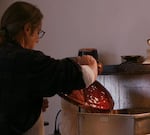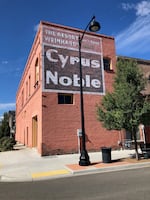Like many other artists, San Diego-born Robert Anders supplemented his creative work with “day jobs” that had him living in cities from Minneapolis to Kansas City. But when it came time to consider retirement, Baker City, Oregon, looked like the perfect spot to settle.

"Bronze provides an open palette to explore various design motifs provided that they flow; natural shapes - the leaves, the branches of a tree - bronze tends to flow that way." - Robert Anders
Jule Gilfillan / OPB
“Here in Baker City, we’re surrounded by beautiful nature. And I often work with trees or bushes and I draw my inspiration primarily from these natural objects,” says Anders.
Anders’ inspiration results in plein air paintings, ceramic vessels and finely detailed prints that cover the walls of his workshop and gallery. But it’s Anders’ bronze vessels that make the biggest impression.
Some 30 years ago, Anders got a job at a Colorado foundry and fell in love with lost-wax bronze casting. The ancient craft involves creating a form in wax that then melts out (is “lost”) in the casting process, producing an exact copy in bronze.
“I got the idea that you could probably throw wax on a potter’s wheel for casting directly into bronze. And so that singular idea really just carried me a long way until I realized what a big hot mess that is,” he recalls with a rueful chuckle.

Anders starts his "lost-wax" bronze-making process by carving a design motif into clay.
Dan Evans / OPB
Looking for ways to get the fine-textured results he wanted without burning his hands, Anders decided to build his wax forms on top of models he first molded in clay. Liquid wax is then poured onto the sculpted clay surface to create a wax relief version of the design.

Artist Robert Anders ladles liquid wax over a clay form to create a wax positive. "I’ve always wanted to do this with chocolate, and make some kind of crazy chocolate bowl." - Robert Anders
Dan Evans / OPB
Once dry, the wax form is pried off the clay one for fine tuning with various knives, dremels and finally, a hot iron. Finally, a “sprue” is attached to the bottom. That’s the sort of funnel through which the bronze will be poured. The wax form is then ready for sending off to the foundry for casting.
Fortunately, many places in Eastern Oregon and Washington have bronze foundries. But for Anders, Baker City offered more than just access.
“Because it’s a little isolated, it was quite affordable. Or at least it was 10 years ago,” Anders explains. “I had some retirement and decided to invest and rehab this beautiful old building.”
Anders’ 1890 red brick building was home to a liquor distributor, most notably Cyrus Noble, distiller of “the whiskey that won the west.” The interior space’s 17-foot ceilings give it an expansive feel, which enhances the sense that ideas can roam freely here. In a very real way, the beautifully restored structure is one of his artworks.

Robert Anders' 1890 Baker City live-work space is the former home of a liquor distributor, including the "Whiskey that won the West."
Robert Anders / Courtesy of the artist
Over a two-year stretch, Anders converted the second floor to a 2500-square-foot living space, complete with a working elevator. Downstairs, the building’s storefront provides entry to a gallery where he shows his work. Behind the gallery, the artmaking space contains both a quiet, clean painting studio as well as a workshop with a garage door that opens to the street.
“That’s my dirty workplace where I grind and work on bronze and make a big mess,” he laughs.
Anders’ lofty live-work space gives him all the room, tools and resources he needs to produce an abundance of artwork. But after a lifetime of doing just that, Anders still approaches his work with reverence and humility.
“I’m striving to be competent as a craftsman, as a painter. I’ve gone through all the iterations of trying to paint in realism and loosening back up. Or trying to sculpt in realism and then loosening back up. My art practice is really about letting things roll, kind of letting them unfold, seeing how they develop.”
